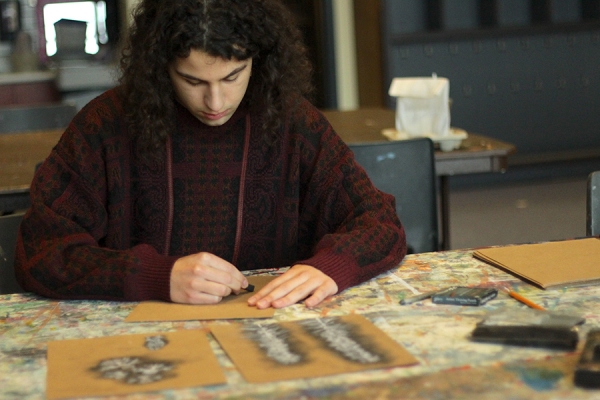 Biology grad Andrea Bresolin is an emerging artist in residence with Art Windsor Essex.
Biology grad Andrea Bresolin is an emerging artist in residence with Art Windsor Essex.
Recent graduate Andrea Bresolin (BSc 2022) took her scientific training and passion for the arts to become the latest Emerging Artist in Residence with Art Windsor Essex (AWE).
“Using art as a way to get people to observe is a strong tool for education on the natural sciences,” says Bresolin.
The 2022 three-month residency runs September through November and includes community outreach, a solo exhibition and creating digital content as an educational tool.
For one of her outreach activities, Bresolin led a guided hike through trails around Ojibway Nature Centre.
“I introduced people to different organisms and had them direct their attention to the fine details that make up different species.”
Bresolin will also work with different fibres to weave works of art.
“There is a science to working with a lot of these dyes and materials but there is also, through the process of doing art, learning about those plants and organisms,” she says.
“Everything I’m doing is very much intentional in getting people to learn about the natural world but using art to do that.”
During her time in the Faculty of Science at UWindsor, Bresolin became one of the original members of UWindsor’s Science Meets Art (SMArt) program as well as becoming a SMArt lead.
While an integrative biology undergraduate, Bresolin did her thesis with Catherine Febria in the Healthy Headwaters Lab at the Great Lakes Institute for Environmental Research (GLIER) on macroinvertebrate diversity and trends across the Sydenham River watershed. She is currently a research assistant in the lab doing benthic biomonitoring.
“There are similarities that doing an undergraduate thesis in science prepared me for the process of creating something larger like an installation,” says Bresolin.
“A lot of the processes of developing a scientific hypothesis, and identifying the steps to getting there, are very similar to how the creative process works.”
Acting dean of science Dora Cavallo-Medved mentored Bresolin throughout her time in the SMArt program. She says that fostering creativity in science provides more opportunities for student engagement.
“In addition to their scientific contributions, Andrea’s creative work in the Faculty of Science has also allowed other students to develop their interest in the arts as a mechanism for communicating science. This also creates a more inclusive learning environment for all students in science”, says Dr. Cavallo-Medved
Bresolin’s solo exhibition, which looks at the Black Oaks savannah ecosystem and the role that fire plays in it, will be featured at the Dry Goods Gallery, at 1012 Drouillard Rd. through Jan. 25.For more on Bresolin head to the AWE website.
—Sara Elliott
